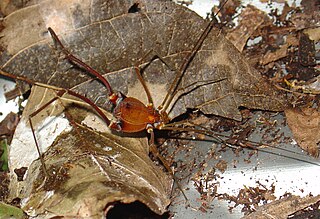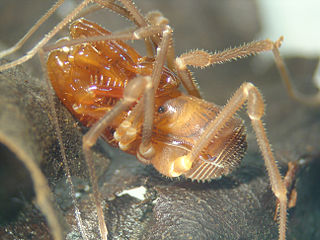
The Opiliones are an order of arachnids colloquially known as harvestmen, harvesters, harvest spiders, or daddy longlegs. As of April 2017, over 6,650 species of harvestmen have been discovered worldwide, although the total number of extant species may exceed 10,000. The order Opiliones includes five suborders: Cyphophthalmi, Eupnoi, Dyspnoi, Laniatores, and Tetrophthalmi, which were named in 2014.

Gonyleptidae is a neotropical family of harvestmen with more than 800 species, the largest in the suborder Laniatores and the second largest of the Opiliones as a whole. The largest known harvestmen are gonyleptids.

Gonyleptoidea is the most diverse superfamily of the Grassatores. It includes around 2,500 species distributed in the Neotropics. They are characterized by the simplified male genitalia, with the glans free subapical in the truncus.

Samooidea is a large superfamily in the Grassatores group of harvestmen. It includes around 380 species distributed throughout the tropics. They are characterized by the complex male genitalia, with eversible complementary sclerites.

Cosmetidae is a family of harvestmen in the suborder Laniatores. With over 700 species, it is one of the largest families in Opiliones. They are endemic of the New World with a Nearctic-Neotropical distribution where a large fraction of the diversity of Opiliones are represented by this single family. Cosmetidae have the northern extent of their range into the USA, where a small number species occur in the southern states. However, the family is especially diverse in Mexico, Central America and northern South America; especially the Andean realms. Their range also extends further south into Argentina and southern Brazil, but they are absent in Chile. Cosmetidae are prevalent in Amazonian region, but only relatively few also occur in Brazilian Atlantic Forest. Several species are also found in the Caribbean.

The Eupnoi are a suborder of harvestmen, with more than 200 genera, and about 1,700 described species.

The Neogoveidae are a family of harvestmen with 27 described species in eight genera. However, eight species of Huitaca, 17 species of Metagovea and 12 species of Neogovea are currently awaiting description.

Assamiidae are a family of harvestmen with more than 400 described species. It is the third most diverse family of the suborder Laniatores.
The Stygnopsidae are a small family of harvestmen, with almost all species found in Mexico.
The Stygnidae are a family of neotropical harvestmen within the suborder Laniatores.
Agoristenidae are a neotropical harvestman family of the Suborder Laniatores, in the superfamily Gonyleptoidea.
The Manaosbiidae are a family of neotropical harvestmen within the suborder Laniatores.
The Icaleptidae are a small family of neotropical harvestmen within the suborder Laniatores. Although only two species have been described, many more are probably to be discovered.
The Zalmoxidae are a family of harvestmen within the suborder Laniatores.
Escadabiidae is a small neotropical family of the harvestman infraorder Grassatores with six described species.
Kimulidae is a small neotropical family of the harvestman infraorder Grassatores with about thirty described species.

Stygnommatidae is a small neotropical family of the harvestman infraorder Grassatores with about thirty described species.

The Cladonychiidae are a small family of harvestman with about 33 described species, within the suborder Laniatores.
Taito is a genus of harvestmen in the family Cosmetidae. The genus is endemic to the Amazon Basin in Brazil, Colombia, Ecuador and Peru.
Metasarcidae is a family of harvestmen, first described by Adriano B. Kury in 1994.








